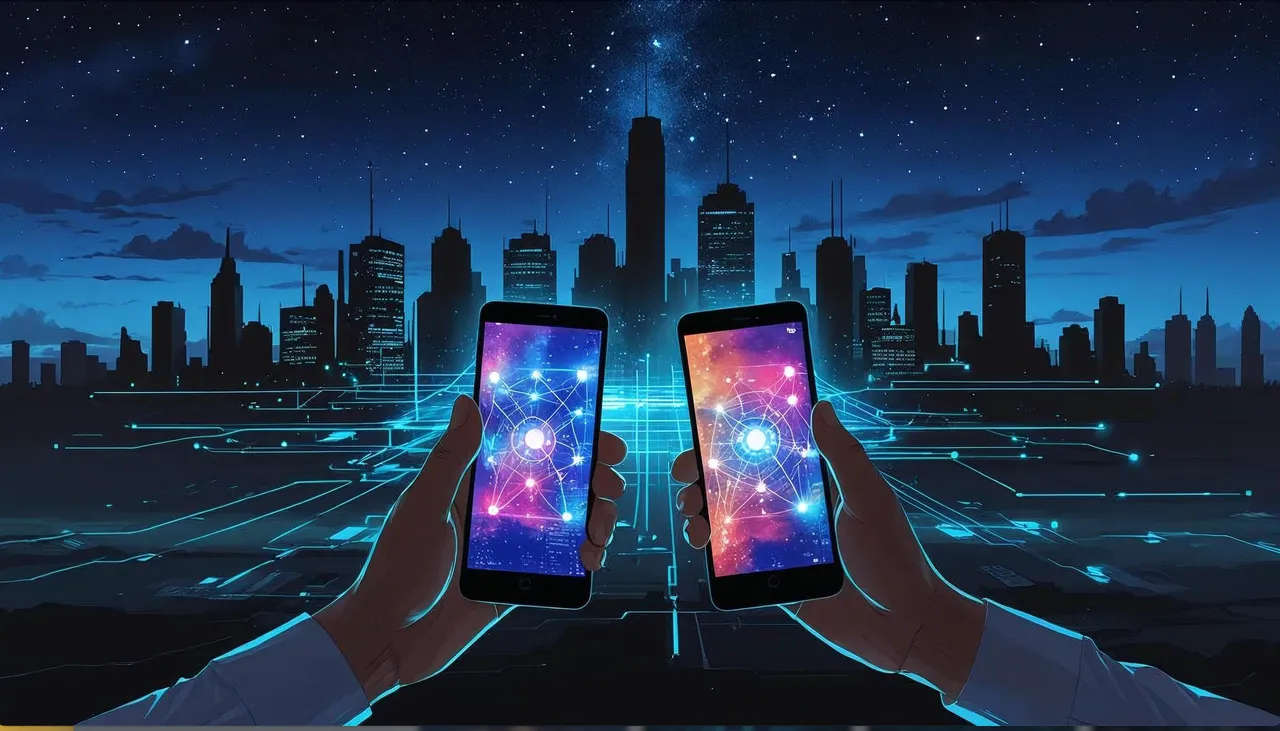Your Phone Has a Secret Network!
This Tech Lets You Text With ZERO Signal
Part Five: Low Energy Bluetooth Mesh Networks:
Introduction:
The implications of using Bluetooth Low Energy (BLE) for decentralized communications are significant, representing both a powerful opportunity for off-grid messaging and a formidable challenge for real-time voice.
- In part five I address briefly two things : Part 1. Decentralized Free Text MessageingLet's break it down, starting with decentralized text messaging and then Part 2 Decentralized Free Voice Phone Calls.
Part 1: Implications for Decentralized Text/Instant Messaging
This is where BLE is already making an impact. Using BLE, phones can create a mesh network, relaying messages from device to device without needing Wi-Fi or a cellular network.
How It Works
- Mesh Networking: Instead of a direct A-to-B connection, a message can hop from Phone A to Phone B, to Phone C, and finally to its destination, Phone D. Each user's phone becomes a node in the network.
- Store-and-Forward: If a direct path isn't available, a user's phone can hold onto a message until it comes within range of another user, then forward it along the chain.
- Broadcasting: BLE is excellent at sending out small "advertisement" packets of data that can be picked up by any device in range, forming the basis of device discovery and short message broadcasts.
Real-World Examples: Apps like Bridgefy and Briar have famously used this technology, particularly during protests or natural disasters where internet connectivity is cut off.
Key Implications
| Implication | Positive (+) | Negative (-) |
|---|---|---|
| Connectivity | True Off-Grid Communication: Enables communication in disaster zones, remote areas, large crowds (concerts, sports), and scenarios of internet censorship. | Density Dependent: The network is only as strong as the number of users. It is useless in sparsely populated areas as there are no "hops" for the message. |
| Censorship & Privacy | Highly Censorship-Resistant: With no central server, it's extremely difficult for an authority to shut down the network. End-to-end encryption can secure messages as they hop between nodes. | Anonymity Challenges: While messages can be encrypted, network traffic analysis could potentially identify who is participating in the network if not carefully designed. Malicious nodes could attempt to disrupt the network. |
| Power Consumption | Extremely Low Power: This is the core advantage of BLE. Phones can participate in the mesh network all day without a significant battery drain, unlike Wi-Fi Direct or classic Bluetooth. | N/A (This is BLE's primary strength) |
| Performance | Cost-Free: Communication does not use cellular data plans. | High Latency & Low Bandwidth: Messages are not instant. The "store-and-forward" nature and multiple hops mean delivery can take minutes or even longer. It is unsuitable for large files or images. |
| Range | Extends beyond a single device's range through mesh hopping. | Very Short Individual Range: The range between any two individual phones is limited (typically under 100 meters), making network density critical. |
Part 2: Decentralized FREE Voice Communications: evolving from Free Texts to Free Phone Calls.
This is the holy grail of off-grid communication and where BLE faces fundamental challenges. While it is evolving, true, real-time voice conversations over a multi-hop mesh network are a huge leap.
The short answer is: Don't expect a full-duplex, seamless voice call over a large BLE mesh network anytime soon. However, a limited "walkie-talkie" style communication is becoming feasible.
The Overwhelming Technical Hurdles
Bandwidth: Standard BLE has very low data throughput (practically well under 1 Mbps). Voice communication requires a continuous, stable stream of data. Even with modern compression, this is a heavy lift for a technology designed to send tiny packets of sensor data intermittently.
Latency: This is the killer. For a natural conversation, end-to-end latency needs to be below ~200 milliseconds. Every single "hop" in a mesh network adds delay (processing and re-transmission time). A conversation hopping across just 3-4 phones would almost certainly exceed this threshold, resulting in a frustrating and unusable delay, similar to old satellite phone calls.
Jitter & Packet Loss: A mesh network is not a stable connection. Packets can be dropped or arrive out of order (jitter). For text, this is okay; the message just gets reassembled. For a real-time voice stream, this results in dropouts, garbled audio, and robotic sounds. Buffering can smooth out jitter but adds even more latency.
The Path to Feasibility: LE Audio and Future BLE Standards
Despite the hurdles, progress is being made. The evolution will likely happen in stages, enabled by new Bluetooth standards.
LE Audio & the LC3 Codec: This is the single most important development. The new LC3 codec is a game-changer for Bluetooth audio. It can produce high-quality audio at much lower data rates than the old standard (SBC) and is far more resilient to packet loss. This dramatically lowers the bandwidth hurdle.
Auracast™ Broadcast Audio: This new feature of LE Audio allows a single device (like a phone) to broadcast one or more audio streams to an unlimited number of devices in range. While this is one-to-many, it demonstrates the core capability of streaming audio over BLE.
"Walkie-Talkie" (Push-to-Talk) as a First Step: A full, two-way phone call (full-duplex) is likely out of reach. However, a half-duplex, "Push-to-Talk" (PTT) system is far more realistic.
- It's less sensitive to latency (people are used to a slight delay with walkie-talkies).
- It cuts the bandwidth requirement in half since only one person is transmitting at a time.
- This could be built on Auracast-like principles for a one-to-many PTT or a more directed one-to-one PTT.
Last Words
For decentralized text, BLE is a viable and powerful technology available today, providing a critical lifeline when infrastructure fails. Its main limitations are its dependence on user density and high latency.
For decentralized voice, BLE is not there yet and faces fundamental physics and protocol challenges regarding latency and jitter in a multi-hop mesh.
It will likely never evolve into a system that can replicate a free, real-time cellular phone call over a wide-area mesh network. However, thanks to LE Audio and the LC3 codec, it is rapidly evolving to a point where limited-range, push-to-talk "walkie-talkie" functionality is becoming technologically feasible. This would be a significant step forward, but it's important to have realistic expectations about its capabilities.
The End
If you like content like this, please click Follow and please hit ReBlog to share my content with others.
If you share this post on X and paste the link in a comment I will upvote that comment!
Thank You
@shortsegments

